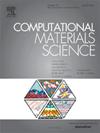热等离子体射流中金属和陶瓷粉末的球化
IF 3.3
3区 材料科学
Q2 MATERIALS SCIENCE, MULTIDISCIPLINARY
引用次数: 12
摘要
在本研究中,从基本流体动力学方程对颗粒球化率进行了理论估计。在不同的等离子体气体流速和温度(输入功率)下考虑不同尺寸的粒子。计算了颗粒在飞行中的停留时间和熔化时间,并利用它们估算了球化率。发现球化强烈依赖于颗粒尺寸和等离子体喷射温度。本文章由计算机程序翻译,如有差异,请以英文原文为准。
Spheroidization of metal and ceramic powders in thermal plasma jet
In the present investigation, a theoretical estimation of the percentage of spheroidization of particles has been made from basic fluid dynamic equations. Particles of different sizes were considered at different plasma gas flow rates and temperatures (input power). Particle inflight residence and melting times were calculated and using them, percentage of spheroidization was estimated. Spheroidization was found to be strongly dependent on particle size and plasma jet temperature.
求助全文
通过发布文献求助,成功后即可免费获取论文全文。
去求助
来源期刊

Computational Materials Science
工程技术-材料科学:综合
CiteScore
6.50
自引率
6.10%
发文量
665
审稿时长
26 days
期刊介绍:
The goal of Computational Materials Science is to report on results that provide new or unique insights into, or significantly expand our understanding of, the properties of materials or phenomena associated with their design, synthesis, processing, characterization, and utilization. To be relevant to the journal, the results should be applied or applicable to specific material systems that are discussed within the submission.
 求助内容:
求助内容: 应助结果提醒方式:
应助结果提醒方式:


